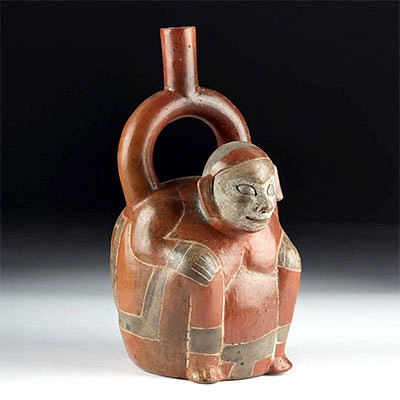Late 20th C. African Songye Wood Standing Male Figure
Lot 271
About Seller
Artemis Gallery
686 S Taylor Ave, Ste 106
Louisville, CO 80027
United States
Selling antiquities, ancient and ethnographic art online since 1993, Artemis Gallery specializes in Classical Antiquities (Egyptian, Greek, Roman, Near Eastern), Asian, Pre-Columbian, African / Tribal / Oceanographic art. Our extensive inventory includes pottery, stone, metal, wood, glass and textil...Read more
Categories
Estimate:
$550 - $825
Absentee vs Live bid
Two ways to bid:
- Leave a max absentee bid and the platform will bid on your behalf up to your maximum bid during the live auction.
- Bid live during the auction and your bids will be submitted real-time to the auctioneer.
Bid Increments
| Price | Bid Increment |
|---|---|
| $0 | $25 |
| $300 | $50 |
| $1,000 | $100 |
| $2,000 | $250 |
| $5,000 | $500 |
| $10,000 | $1,000 |
| $20,000 | $2,500 |
| $50,000 | $5,000 |
| $100,000 | $10,000 |
| $200,000 | $20,000 |
About Auction
By Artemis Gallery
Jul 8, 2021
Set Reminder
2021-07-08 10:00:00
2021-07-08 10:00:00
America/New_York
Bidsquare
Bidsquare : CLEARANCE | Ancient & Ethnographic Art
https://www.bidsquare.com/auctions/artemis-gallery/clearance-ancient-ethnographic-art-7173
Kick off summer with our clearance sale featuring discounted pricing and many new items at superb prices! Asian art, Classical antiquities from Egypt, Greece, Italy, and the Near East...plus Pre-Columbian, Tribal, Russian Icons & Enamelware, Spanish Colonial, Fine Art, Fossils, more! Artemis Gallery info@artemisgallery.com
Kick off summer with our clearance sale featuring discounted pricing and many new items at superb prices! Asian art, Classical antiquities from Egypt, Greece, Italy, and the Near East...plus Pre-Columbian, Tribal, Russian Icons & Enamelware, Spanish Colonial, Fine Art, Fossils, more! Artemis Gallery info@artemisgallery.com
- Lot Description
**Originally Listed At $300**
Central Africa, northern Democratic Republic of the Congo, Songye peoples, ca. 1980s CE. A wonderful carved-wood figure known as a nkisi (male) power figure of a substantial size depicted standing on a circular base with his hands on their rotund belly. Supported by a ribbed, tubular neck, the stylized figure's oversized head showcases a long square chin, a smiling mouth, a triangular nose, and slender slanted eyes under an arched brow, all flanked by a pairof incised ears. Attenuated arms hang from his square shoulders, while his bulbous belly hangs over his cuboid legs, flat feet, and phallus. The intriguing figure is adorned with an animal fur loin cloth held up by a tasseled woven rope of vegetal fiber and an elaborate headdress of cloth, fur, and a strand of red and yellow glass trade beads that cascade down his back and wrap around his chest. A strand of white and blue glass trade beads, a strip of fur, and a woven fiber rope are all coiled around his body. A cavity atop the head originally held a horn symbolic of a power conduit. Rich brown patina covers the entire figure and provides for an attractive presentation. Size: 7.375" W x 27.5" H (18.7 cm x 69.8 cm)
Songye power figures are created to protect a community and mediate between the living and spiritual realms to cure ailments. Figures that are employed in ceremonial uses have real horns protruding from the center of the head and often also exhibit hammered brass panels which are applied to the face. Power figures are kept in a sanctuary under the care of a guardian when not in use.
The piece exhibits a few characteristics which are unique to Songye artistry. Kalebwe figures, from the northern region of the Democratic Republic of the Congo, tend to have chins with a square profile rather than rounded chins typical of the southern Kibeshi figures. The second feature is the hollowed receptacle at the top of the head which is intended for the insertion of fetish material, known as "bishimba," which symbolically imbues the figure with special powers. According to Jean-Baptist Bacquart, "A 'specialist', called the Nganga, then attached magical objects such as snakeskins, feathers, metal necklaces and bracelets to the figure to enhance the power even more. Occasionally these figures are suspended for apotropaic purposes inside a house by inserting a metal rod under each arm." ("The Tribal Arts of Africa: Surveying Africa's Artistic Geography." Thames & Hudson, New York, 2000, p. 168)
Provenance: Ex-Phoenicia Holyland Antiquities
All items legal to buy/sell under U.S. Statute covering cultural patrimony Code 2600, CHAPTER 14, and are guaranteed to be as described or your money back.
A Certificate of Authenticity will accompany all winning bids.
We ship worldwide and handle all shipping in-house for your convenience.
#162642Expected age wear with stable fissures and a few light nicks/chips to peripheries. Otherwise, excellent with rich earthen deposits and liberal remains of fur.Condition
- Shipping Info
-
All shipping is handled in-house for your convenience. Your invoice from Artemis Gallery will include shipping calculation instructions. If in doubt, please inquire BEFORE bidding for estimated shipping costs for individual items.
-
- Buyer's Premium



 EUR
EUR CAD
CAD AUD
AUD GBP
GBP MXN
MXN HKD
HKD CNY
CNY MYR
MYR SEK
SEK SGD
SGD CHF
CHF THB
THB














